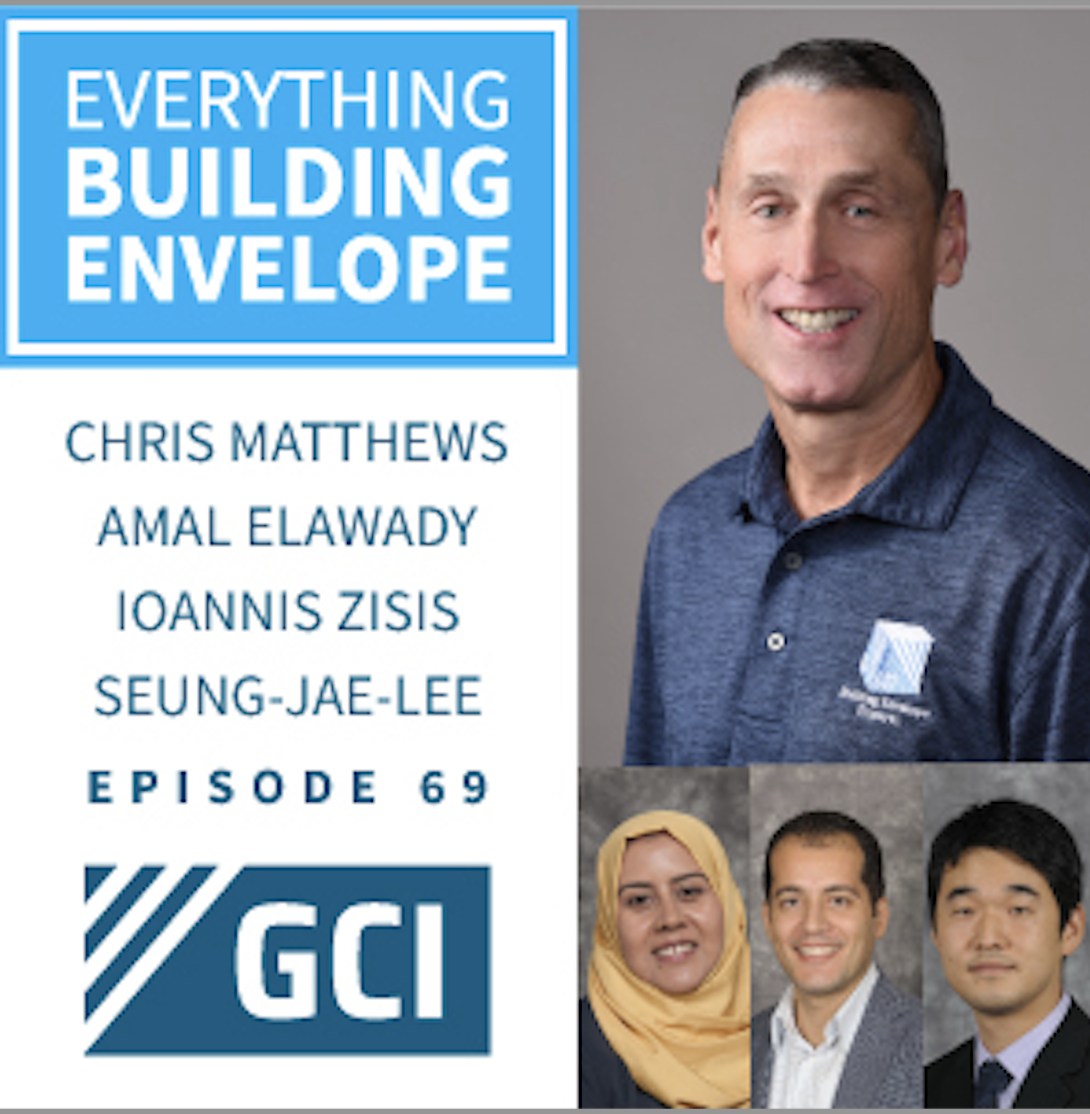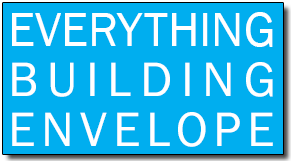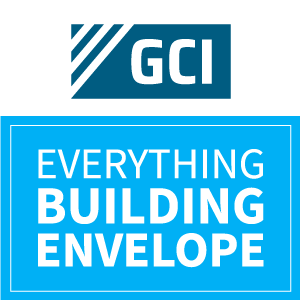
About The Everything Building Envelope Podcast: Everything Building Envelope℠ is a dedicated podcast and video forum for understanding the building envelope. Our podcast series discusses current trends and issues that contractors, developers and building owners have to deal with related to pre and post construction. Our series touches on various topics related to water infiltration, litigation and construction methods related to the building envelope.
https://www.everythingbuildingenvelope.com
*** Subscribe to the show and leave us a Review on ITunes!
Chris: Welcome, everyone, to our “Everything Building Envelope” podcast. I’m Chris Matthews, president and principal for GCI Consultants, and I’m your host today. I’m really excited about our guests today. We have multiple guests from FIU, professors who will be talking to us about the Wall of Wind and other research projects that they do there on exterior building performance during hurricanes. So we’ve got Ioannis, Amal, and SJ, and I’ll let you guys introduce yourselves and tell us a little bit about what you do at FIU, and looking forward to our conversation.
Ioannis: Great. Thank you. It’s Ioannis. This is from FIU. I’m an associate professor in the Department of Civil and Environmental Engineering, and I’m also the co-director of the Laboratory for Wind Engineering Research, which is part of the Extreme Events Institute, also at FIU. Amal?
Amal: Hi. This is Amal Elawady. Thank you again for the invitation. I am assistant professor of Civil Engineering Department at FIU. I’m also a member of the Wall of Wind team and Extreme Events Institute. And my area of research and teaching is related to wind and structure interactions in general. SJ? Thank you.
SJ: Yeah. This is Seung Jae Lee. Typically go by SJ. First of all, thank you for your invitation. So I’m currently associate professor in the same department, Civil and Environmental Engineering at FIU, and I researcher at the Wall of Wind testing facility at FIU, and also NSF with IUCRC center with Ioannis and Amal. I studied at the University of Illinois at Urbana-Champaign and moved to Miami in 2014. And I mostly work on the [inaudible 00:02:05] in various areas, in civil engineering, including structural engineering and geo-mechanics.
So, before coming to U.S., I briefly worked at LG Chemical in Korea, I’m not sure if you know about that company, as a professor and research engineer. Now I think they changed the name to LG Houses. So then I learned a lot about the details, how the facade is designed, tested, manufactured, and installed. So, here at FIU, I’m currently working on a facade project with Amal and Dr. Chowdhury. He is not present here today, but he’s the director of the Wall of Wind engine, the testing facility. So I look forward to talking about those projects more in this podcast, and so I hope this is not much introduction.
Chris: Great. Well, thank you, all, for agreeing to talk to us today. I think if you know a little bit about what we do, we at GCI are out inspecting buildings all the time for the effects of actual hurricanes on those buildings. So I’m super excited to talk to you guys today and learn more about the research work you’re doing. So, can you just give us a little general background on the Wall of Wind, some of the work you guys do there, and why it’s important to the industry?
Ioannis: Absolutely. So, our program, the Wind Engineering program, I think is a legacy of Hurricane Andrew. At FIU, we started with International Hurricane Research Center, IHRC, following that tragic event 20 plus years ago. So, one of the laboratories under the National Hurricane Research Center is the Wind Engineering group.
We went through different iterations of the facility. At the very beginning, there were, like, two portable system with two fans back in 2005, if I’m not mistaken. That was very challenging, but very interesting. Also, we carried out some research using that portable system, dazzling engines and very loud, very useful, also. And then that got us excited. We also managed to secure some more funding, and we upgraded the system to the six-fan system, which was much more capable, obviously. We could test larger specimens and go higher wind speed.
Finally, precisely 20 years from 1992 when Hurricane Andrew happened, we inaugurated the current version of the Wall of Wind, the 12-fan system. Major upgrade there. We have 12 fans, electric systems of 700 horsepower each, were capable to generate up to 157 miles per hour wind speed, which is approximately equivalent to a hurricane 5 category. We have a flow management system to, kind of, like, treat the flow before it reaches the turntable, the specimens, the model that we test. So we try to scientifically simulate the flow field, what we call the atmospheric boundary layer.
The unique advantage of the Wall of Wind is obviously the size. It’s the largest academic-based facility, like large wind tunnel, you may call it. And we can do testing at different scales, starting from a small scale that you see in a typical wind tunnel, 1 to 200, 1 to 100, but we can go up to full scale, 1 to 1. We can test smaller structures or building components at full scale, and we can also do that as high Reynolds number. This is another scientific term, but it’s very important. So we can go up to, as I said, 157 miles per hour at full scale, which is very important.
On top of that, we can introduce wind-driven rain into the flow. We have some sprinklers on the front of the fans, and we can scientifically do that and study the rain impact on the models that we test. So, again, we have the 12 fans. There is a building that houses the Wall of Wind. We have a staging area where we can prepare for the test. That’s where we use, you know, the instrument, the models, and then we move them to the turntable to test them.
We can do also destructive testing. That’s another major advantage. It’s an open-jet facility. We remove all the instrumentation, obviously. We don’t want to damage the instruments. And we can go up to maximum wind speed and see how the different models perform at full scale, as I said, like structure, and see what is the impact of this extreme wind on different buildings or different building components.
At the moment, we have projects that are funded by federal grants, by state agencies, and also private industry. And let’s not forget that this is FIU, Florida International University, so our focus is also educating our students. And Wall of Wind plays a major role in that. We have different courses in wind engineering, and both our undergraduate and graduate students are exposed to this research. We bring them to the lab and show them the type of work that we do.
We’re always, like, you know, current with, you know, what is happening, and they know, not only from a research perspective, but also practical perspective, what wind engineering is about, how the work that we do in the lab ends up in the building code, or wind standard, ASCE standard. So this is very beneficial for our students as well.
And so, I guess, as a closing statement, you know, in your question, with the research we do at the Wall of Wind, we try to quantify and communicate the hurricane risks and losses, and at the same time, we want also to mitigate the impact. So we do a lot of, like, research related to mitigation. And, obviously, sustainability is another big word, or research [inaudible 00:08:18] in our research agenda, and all these different things apply on different types of, like, residential buildings, commercial buildings, infrastructure, power lines, all different kind of things.
Chris: So, a lot of what we do involves water leakage and wind damage, kind of, the combination of that as you guys are doing when you’re introducing water into your testing. I was curious, can you give us another example that someone who’s not a professor like me could understand? Are you introducing the water before there’s damage from the wind, as the wind is damage…how does the water play into some of your investigations of the wind effect?
Ioannis: Yeah. That’s a very good question. We do both, actually. So, wind comes with rain, obviously, and that’s what we do in the lab. That’s what we try to simulate. So, when we turn on the fans, and if it is a wind-driven rain type of project, we’re gonna introduce also the rain component to the flow.
Now, how do we carry out the test? Depends on the application. So, I can talk about one of my projects, and I guess Amal and SJ will talk a lot more about the facade project that they did recently. But I think I completed that project about, like, two years ago. It was collaboration between FIU and Florida Tech colleague that we have there, Jean-Paul Pinelli, Prof. Pinelli. And our focus was interior damage.
So, specific to your question, in this case, we simulated the damage ahead of time, or different damage scenarios on low-rise buildings, the typical low-rise residential structures, and we assume that we have a broken window, or a portion of the roof is missing. And then we introduce the rain component and we wanted to see how the water is distributed on the interior compartments of our model. We had different rooms. So, depending on the damage scenario or the damage level, we could quantify the level of damage on the interior of the building due to water intrusion. So that was one example.
In other cases, we do like the model is intact, but we have a strong wind. Damage might happen. We add the water component and see what happens, you know. And it could be related to, I don’t know, like, shutters, or it could be, like, sliding doors. We have done some projects. Or a roofing element, and we want to see how much water goes inside this house during strong wind event and after the damage is initiated.
Chris: Okay. Interesting. Yeah. So, we’re, kind of, doing that on a very rudimentary scale in the field when we’re investigating some of these buildings that have been affected by wind, and we’re water-testing afterward because lots of times, we get reports from the building occupants that something that wasn’t leaking prior to the storm and doesn’t exhibit a lot of visible evidence of damage is now leaking during regular thunderstorms, that kind of thing.
Ioannis: Yeah. We got similar feedback from different partners, industry partners, I would say, and that is basically the reason we started doing research in that field. And Amal and SJ, they did that project, and they’re gonna have a lot more to share, I guess.
Chris: Okay. All right. Well, and maybe that leads us into the project that you guys worked on, Amal and SJ. Can you tell us something about that?
Amal: Yeah. Thank you for the great introduction. I think it will make my talk easier. So, basically, this project was funded by WHIP Center, IGSU WHIP Center, which is a collaboration between industry, NSF, National Science Foundation, and academic institutions. FIU, and Texas Tech, and FIT are part of the center. So we have a site at FIU basically. So the industry partners were interested to see how the facade, like certain types of curtain wall systems are behaving against wind and wind-driven rain.
The interests are coming from industry like manufacturer, like Permasteelisa, and also insurance companies because they wanted to see, like, the projections of, like, insurance change, for example, after a hurricane or water intrusion. Sometimes it’s all about water intrusion, not the damage of the facade itself. So there was, like, a high interest in that project from our industry partners.
And we worked with the manufacturer in the group, which is Permasteelisa, to design, like, a full-scale specimen representing two types of facade. They provide us with a single-sin facade and a double-skin facade. Thanks to the large section of the wall point, we were able to test full-scale model. So we didn’t reduce the specimen or scale it down at any point. We used, like, a full-scale model of our specimen. We created, like, a small room from that facade system. The dimensions…SJ, you can correct me if I’m wrong, it was, like, around 16 by 18 length and width, was about, like, 12 sheets high?
SJ: Yeah. So 12 and 6.
Amal: Okay. And with the single-skin facade, we tested two different configurations, one representing a small facade with no protrusion element, and the other one we wanted to mimic the case where we have shading devices which the industry use or for architectural reasons.
Chris: Sun shade on the exterior of the curtain wall?
Amal: No. We were collaborating. Like, I was taking care of the experimental part, and SJ was taking care of the numerical simulation. So, basically, there was two methods used in that project. We wanted to assess the specimen experimentally and then try to simulate the same experiment in, like, using numerical simulation, and then we can extend that to, like, a perimeter study. I will let SJ talk more about the numerical part. So, I was just trying to give an overview of the experiment.
So, for the single-skin facade, as I said, we likely tested a small surface, and another surface was vertical [inaudible 00:14:46] or vertical shading device to see how…the main objective basically was how the additional testing is important from a [inaudible 00:14:55] point of view and architectural point of view, but how it would impact the performance of the structure, how the vibration would be different. And is there any correlation between wind-induced vibrations and water intrusion?
So we applied, like, wind-driven rain, like what Ioannis was mentioning, to see at different wind speed, in different wind directions, to see how they are correlated, both wind-induced vibration and wind-driven rain for both cases, the flat surface and the surface with shading device. SJ, do you want to talk a bit about the numerical part?
SJ: Right. Thank you, Amal. So, I’m collaborating with Amal on this project. So, definitely, the framework, we like to develop this kind of integrated, experimental and numerical analysis framework for the facade system. So, definitely, one of the objective would be to inform design standard for curtain wall or facade industry regarding the wind-induced resonant vibration of the facade system. So, ASCE 7 standard says structures with natural frequencies above 1 hertz do not need to be analyzed for wind-induced dynamic effects.
So this criterion was originally developed with a typical building size in mind, but this has been often viewed by some practitioners as also applicable to building facades which are much smaller and steeper. So, it was reported that many facades failed because of the wind-induced resonant vibrations, and definitely their natural frequencies are clearly above 1 hertz because it’s smaller and steeper. So building facades, so the 1 hertz criterion can be misleading.
So, what we are doing is, Amal is responsible for the experiment testing at the Wall of Wind, and we use that experiment data to calibrate the numerical model we developed using finite element methods. So, well, [inaudible 00:17:02] method, every continuous system is discretized into a smaller, so called the finite element, and then we just mathematically model that system into a set of linear equation and solve that in computer. And the beauty of this approach is we can do some parametric studies without any further experiment at the Wall of Wind.
So we calibrate the model based on the acceleration and strain data we obtained at the Wall of Wind, and then we just make the system to be calibrated based on data such that it can perform as observed is at the Wall of Wind experiment facility. And then we just do some kind of parametric studies like different wind direction, different wind speed.
And, also, we just change some properties like change the size of the frames, and also change the thickness of glass, and also change the properties of the silicon glazing, and so on and so forth, and then we can study the wind-induced vibration of the different systems in the computer by changing those parameters. So that is the beauty of this approach.
So, we definitely want to investigate the interrelation between the wind-induced resonant vibration and the water intrusion, because water intrusion is actually the real problem in many cases, so that the damage is interior and utility inside the building. So, definitely with more wind-induced vibration, and it is likely to have more water intrusion inside the building. So we try to better understand the correlation between these two phenomena. So that is definitely one thing.
And, also, I work with Dr. Chowdhury, but this is kind of related project. But we also use the same specimen with focus on the upper part in the facade system. So often, you know, the facade system has the upper part, like window, even for the curtain wall. But the main thing here is often that the upper parts just fail because of fatigue in the hardware.
So that is caused by often different natural frequencies between the upper part and the main facade. So that is affecting the hardware, and that causes the fatigue failure. So we also try to look at failure mechanism through this kind of integrate experimental and numerical analysis framework.
Chris: And you assess that further through your modeling program? Or, did you actually test different hardware in the Wall of Wind, or was that more through the modeling program?
SJ: So, we first need to do the testing. So we already test it, and then we saw the dynamic behavior of the upper part. We put the sensors, accelerometers, and the strain gauges, and then we cut the data, and then we calibrate our numerical model with upper part so it can behave the same as we observed in the experiment facility based on the acceleration and the strain gauge.
And then we can better understand the mechanism of the failure. So we indeed saw some different frequencies between natural frequencies of the upper part and the main facade system, and we believe that is somehow affecting the fatigue failure mechanism of the hardware.
Chris: Interesting. As I had mentioned, you know, we’re out looking at these failures in the real world after the hurricane, and I don’t think that that concept has even been considered at the point in the process that we are. Because all the discussion is buffeting winds, opening joint, those kinds of things, but it’s not this vibration component that you’re investigating.
SJ: Vibration is a big issue. Yeah. Definitely. So we are seeing some limited number of research in this topic, and hopefully we can contribute to the body of knowledge.
Chris: Great. Well, and, as you said, ultimately from the industry standpoint, it’s the mitigation factors. Once you guys understand better how to make these systems perform better, then we in the industry can respond to that and design accordingly.
SJ: Sure. Yeah. Definitely. In academia, we first start with understanding characterization, and then investigation will be followed, for sure, yes. So, Amal, I think you want to say something.
Amal: No. I was [inaudible 00:21:47] and, yeah, having an industry partner in that project, collaborating with us, helping us with the installation and, you know, specimen design, like, it was essential, actually, because we didn’t want to change anything that happens in reality, in the real life there in the site from what we were testing. So we wanted to be, like, very accurate, replicating, like, a real-case scenario and test so we can really form a meaningful result. So it was also very important to have industry experience helping us to advance this knowledge, actually.
Chris: Yeah. Well, and it sounds to me from your description of your test specimens that they were similar to what we would test for certification of windows, doors, curtain walls, etc., for both impact resistance, water resistance, and structural. Go ahead, sorry.
Amal: Sorry for interrupting. Yeah. Well, this is interesting part because we wanted to test, like, in a proper way, but it’s not replicating the certification testing. So, basically we have some questions about, like, how the certification testing is realistic to assess, like, the wind-induced vibration or wind-driven rain, performance of the facade, because, apparently, like, for example, static pressure testing, that is not representing a real dynamic when it’s checked on the facade, right?
Chris: Right.
Amal: Having, like, just one fan focused on one panel is not replicating the case. So we have some certain questions related to the certification testing, and we wanted to assess that in the lab by measuring, or by trying to replicate the real [inaudible 00:23:36] or real scenario, basically, for wind and rain together.
So, for wind, for example, we tested wind speeds from 90 miles per hour, all the way up to 140 mile per hour. For rain, as well, we wanted to simulate a wind-driven rain case scenario that happens during hurricane events, so by matching what real rain events that were reported in the future. So, how is that close to certificate? This is a whole new question, or another question that we are trying to answer in that project as well.
Chris: Right. And I think that could have a big impact as well, moving forward in the industry, if the certification testing was more representative of, you know, real conditions, not just a static pressure test as you mentioned, you know, the specific laboratory tests, which maybe don’t really replicate what these systems are exposed to, at least in the areas we’re talking about, coastal regions where there’s hurricanes, those kinds of things.
And we talk about that a lot when we’re consulting with architects, designers in that, “Here’s what the code requires. Here’s the certification of these systems, what they meet, but you’re building this condominium on the beach where a hurricane will come, it’s just a matter of when. And, do you want to design it to a higher standard so you get better performance?” Which would go all the way back to the certification testing if we were really doing it the right way.
So that would be great feedback. You know, I’m sure it’ll take a long time. But if your research came back all the way to the industry and we looked at it from the certification standpoint, I think we’d get a lot better performance in our buildings moving forward.
Amal: Yeah. We hope to get feedback from our industry partners and interested parties, policymakers. I’m sure that will take time, but I think that was, like, a first step.
Chris: Yeah. And you mentioned Permasteelisa was, kind of, your system provider for your testing, and we’ve worked with them specifically on building real projects in Miami Beach, that kind of thing, big condominium projects with their system. So they’re a great partner and representative of what’s being built right now.
Amal: That’s interesting to know. Yeah. They were a great partner in the project.
Chris: Well, thank you, guys, so much for joining us today. I think I got most of what you were explaining. Some of it is over my head, but it’s super interesting and we really appreciate your joining us in our podcast. I think our listeners are gonna get a lot from the conversation. Any closing remarks that any of you have that you’d like to finish up with?
Ioannis: Thank you for providing us with the opportunity, you know, to discuss and present what we do at the Wall of Wind. Should mention that, you know, again, like, Hall of Wind is part of an academic institution, FIU, so the focus is educating the students, but at the same time, you know, we try to stay close to the industry and to listen to the problems they have.
And I guess the discussion we had today is a great example of how things started, doing research for a real problem, you know. And staying connected to the industry, that always helps us be relevant, you know. The research we do is a practical application, a problem that exists out there, and we try to investigate that in the lab. So, again, thank you for the time you gave us today to discuss all these things.
Chris: Yeah. And I can definitely attest to the fact that it’s a real problem because we’re out looking at buildings every day that could have performed much better even when there’s not catastrophic damage. So I think the work you guys are doing is right on track with what is needed moving forward. So thank you again for joining us today. We invite all of our listeners to investigate our services more on www.gciconsultants.com. I thank our guests from FIU, and I look forward to talking with you again on our next “Everything Building Envelope” podcast.
In closing I would like to thank you for listening to our podcast today.
Ioannis, if any listeners want to reach out to you or your team, what is your website address and the best way for them to contact you or FIU?
We also invite you to take a further look at our GCI Consultants services on our website at: www.gciconsultants.com
You can also reach us at 877.740.9990 to discuss any or your Building Envelope needs.
Thank you once again and I look forward to talking with you the next time on our Everything Building Envelope podcast.




